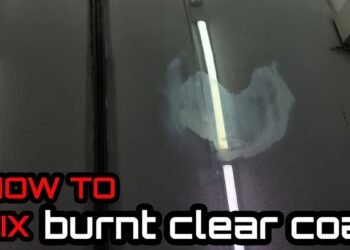Are your spark plugs fouled and causing your engine to misfire or lose power? You don’t have to rush out for replacements just yet.
Seafoam offers a simple, effective way to clean fouled spark plugs and bring your engine back to life. Imagine saving time and money by restoring your spark plugs instead of buying new ones. In this guide, you’ll discover how Seafoam works, step-by-step cleaning tips, and important things to watch out for so your vehicle runs smoothly again.
Keep reading to learn how to get the best results with Seafoam and keep your engine firing strong!
Tools And Materials Needed
Preparing to clean fouled spark plugs with Seafoam requires the right tools and materials. Having everything ready makes the process smooth and efficient. It also ensures you protect your spark plugs and yourself during cleaning.
Essential Cleaning Supplies
- Spark plug socket wrench for safe removal
- Seafoam spray or liquid cleaner to dissolve deposits
- Soft brass wire brush to scrub the plug gently
- Clean rag or microfiber cloth to wipe dirt away
- Compressed air can or air compressor to dry the plug
- Fine-grit emery cloth for stubborn carbon buildup
- Gap gauge to check and adjust spark plug gap
Safety Gear
- Protective gloves to keep hands clean and safe
- Safety goggles to shield eyes from cleaner and debris
- Work apron or old clothes to avoid stains
- Well-ventilated area to avoid inhaling fumes
Credit: www.toyota-4runner.org
Removing Spark Plugs
Removing spark plugs is a key step to clean fouled plugs with Seafoam. Careful removal prevents damage to the plugs and engine. This process lets you inspect and clean the plugs properly.
Using the right tools and knowing the spark plug location makes removal easier. Follow simple steps to remove each plug safely and efficiently.
Locating Spark Plugs
Locate spark plugs under the hood on the engine’s cylinder head. Most engines have one plug per cylinder. Look for thick wires leading to each plug. These wires carry electricity to the spark plugs.
Remove engine covers or components blocking access. This may include air filters or plastic shields. Use a flashlight for better visibility in tight spaces.
Using A Spark Plug Socket
Use a spark plug socket attached to a ratchet wrench. The socket fits snugly around the plug’s hex shape. This prevents slipping and damage to the plug.
Turn the wrench counterclockwise to loosen the plug. Do this slowly to avoid breaking the plug or threads. Remove the plug carefully by hand once loose.
Keep the spark plug upright to avoid dirt falling into the cylinder. Place removed plugs on a clean surface for inspection and cleaning.
Applying Seafoam
Applying Seafoam to clean fouled spark plugs can restore engine performance. This process helps remove carbon and oil deposits that cause misfires. Using Seafoam correctly ensures the spark plugs work efficiently again. Below, learn how Seafoam cleans spark plugs and the best ways to apply it.
How Seafoam Works
Seafoam is a petroleum-based cleaner. It dissolves carbon, oil, and sludge inside the engine. When applied, it breaks down deposits on spark plugs. This allows the plugs to spark properly. Seafoam also cleans fuel injectors and intake valves. It helps the engine run smoother and burn fuel better.
Proper Application Techniques
Start by removing the fouled spark plugs carefully. Use a spark plug socket for this step. Next, spray Seafoam directly into the spark plug holes. Let it soak for 10 to 15 minutes to loosen deposits. Avoid pouring too much to prevent flooding the engine.
After soaking, crank the engine a few times. This action pushes Seafoam through the combustion chamber. It cleans the deposits on the spark plugs and valves. Finally, reinstall the spark plugs and start the engine. The plugs should now fire more reliably and cleanly.

Credit: seafoamworks.com
Cleaning Process
Cleaning fouled spark plugs with Seafoam involves a careful step-by-step process. This ensures the plugs regain their efficiency and help the engine run smoothly. The cleaning process removes carbon deposits and oil buildup without harming the spark plug’s structure.
Each step targets different types of dirt and buildup, making the spark plugs ready for reuse. Here is the detailed cleaning process to follow for the best results.
Loosening Deposits
Start by spraying the spark plug tip with Seafoam or a carburetor cleaner. The liquid helps break down carbon and oil stuck on the plug.
Let the cleaner sit for a few minutes. This softens hard deposits and makes scrubbing easier.
Scrubbing With A Wire Brush
Use a soft brass wire brush to scrub the electrodes and threads gently. Brass is less harsh and protects the spark plug’s coating.
Avoid steel brushes as they can cause damage. For tough spots, a fine abrasive like emery cloth works well if used carefully.
Wiping And Drying
After scrubbing, wipe the spark plug clean with a dry cloth to remove loosened debris. This step clears away all dirt particles.
Use compressed air to blow off any leftover cleaner or moisture. A dry spark plug prevents misfires and improves ignition.
Re-gapping Spark Plugs
Re-gapping spark plugs is a crucial step after cleaning fouled plugs with Seafoam. Proper gap size ensures efficient ignition and smooth engine performance. A wrong gap can cause misfires, rough idling, and poor fuel economy.
Checking and adjusting the gap restores the spark plug’s ability to ignite fuel correctly. This process requires simple tools and careful attention to detail.
Checking The Gap
Use a spark plug gap tool to measure the distance between the electrodes. Insert the tool’s feeler gauge into the gap gently. The gauge should slide with slight resistance.
If the tool fits too loosely or not at all, the gap needs adjustment. Compare the measured gap to the vehicle’s specifications. Find the correct gap size in the owner’s manual or service guide.
Adjusting To Specifications
To increase the gap, carefully bend the ground electrode outward. Use a gap tool or a small flathead screwdriver. Make small adjustments to avoid damaging the electrode.
To decrease the gap, gently tap the electrode inward. Check the gap repeatedly during adjustment. Ensure it matches the exact specification for your engine.
After adjusting, clean the spark plug again to remove any debris. Properly gapped and clean spark plugs improve engine start-up and reduce fouling.
Reinstalling Spark Plugs
Reinstalling spark plugs after cleaning is key to engine health. Correct installation ensures the plugs work well and last longer. It also prevents engine issues like misfires or poor fuel economy. Follow proper steps to avoid damage and keep the engine running smoothly.
Proper Threading
Start by hand-threading the spark plug into the cylinder head. This prevents cross-threading, which can damage the engine. Turn the plug slowly and feel for resistance. If it feels tight, back it out and try again. Never force the plug in with a wrench at this stage.
Once the plug turns easily by hand, use a socket wrench to tighten it. Proper threading helps ensure a good seal and prevents leaks.
Torque Recommendations
Use a torque wrench to tighten the spark plug to the manufacturer’s recommended torque. Over-tightening can strip the threads or break the plug. Under-tightening may cause poor performance or plug loosening. Check your vehicle manual for the exact torque value.
Typically, spark plugs need about 20 to 30 foot-pounds of torque. Apply force steadily and avoid sudden twists. Proper torque keeps the plug secure and maintains engine efficiency.
When Cleaning Isn’t Enough
Cleaning fouled spark plugs with Seafoam can restore engine performance in many cases. Yet, some spark plugs suffer heavy fouling that simple cleaning cannot fix. Knowing when cleaning isn’t enough helps prevent engine problems and saves time. This section covers signs of severe fouling and the right time to replace spark plugs.
Signs Of Heavy Fouling
Heavy fouling shows clear symptoms. The engine may misfire or run rough. You might notice poor fuel economy or difficulty starting the engine. Black, oily deposits cover the spark plug’s electrodes. Cleaning attempts often fail to remove these stubborn layers. If fouling returns quickly after cleaning, the plug is likely damaged.
Another sign is a spark plug with broken or worn electrodes. Cracks or excessive wear reduce the spark’s strength. The spark plug gap may also be distorted. These issues cause weak sparks and poor combustion. Such plugs cannot be fully restored by cleaning.
When To Replace Spark Plugs
Replace spark plugs when signs of heavy fouling appear. Also, change them if the electrodes show wear or damage. Follow your vehicle’s recommended replacement schedule. Old spark plugs lose efficiency even without fouling. Using new spark plugs improves engine smoothness and fuel use.
After multiple cleaning attempts, replacement is often the best choice. New spark plugs ensure reliable ignition and prevent engine misfires. Always use the correct spark plug type for your engine. Proper installation and gapping help maintain engine health.
Preventing Future Fouling
Preventing fouling of spark plugs helps keep your engine running smoothly. Consistent fouling can cause misfires and reduce fuel efficiency. Taking steps to avoid future fouling saves time and repair costs. Simple adjustments and care make a big difference in spark plug health.
Fuel Mixture Adjustments
Fuel mixture plays a key role in spark plug fouling. A rich fuel mixture causes excess carbon deposits on plugs. Adjusting the air-fuel ratio improves combustion and prevents buildup.
Use a carburetor or fuel injection system to balance the mix. Ensure enough air reaches the engine for complete fuel burning. Leaner mixtures reduce carbon buildup and keep plugs cleaner longer.
Check for fuel system leaks or faulty sensors that affect mixture quality. Regular tuning of the fuel system maintains optimal spark plug conditions.
Regular Maintenance Tips
Routine maintenance keeps spark plugs in good shape. Change plugs according to the manufacturer’s schedule. Old plugs can foul easily and reduce engine power.
Inspect ignition wires and coils for damage. Weak sparks cause incomplete combustion and fouling. Replace worn components promptly to maintain spark strength.
Keep air filters clean to ensure proper airflow. Dirty filters reduce oxygen supply and lead to richer fuel mixtures.
Use quality fuel and additives like Seafoam to clean the engine internally. This helps remove carbon deposits that cause fouling.
Common Mistakes To Avoid
Cleaning fouled spark plugs with Seafoam can improve engine performance. Avoiding common mistakes ensures safe and effective results. Some errors can damage the spark plug or hide deeper engine problems. Understanding these pitfalls helps maintain your vehicle properly.
Using Abrasive Brushes
Avoid using steel or harsh metal brushes on spark plugs. Abrasive brushes can scratch the electrode and damage the plug’s coating. This damage reduces the spark plug’s lifespan and performance. Use a soft brass wire brush instead. It cleans gently without harming the metal parts. Handle the spark plug carefully during cleaning to prevent breakage.
Ignoring Underlying Engine Issues
Cleaning spark plugs will not fix engine problems causing fouling. Fouling may result from oil leaks, poor fuel mixture, or worn engine parts. Ignoring these causes leads to repeated fouling and engine damage. Always inspect and fix engine issues before cleaning spark plugs. Regular maintenance improves engine health and spark plug life.

Credit: www.youtube.com
Frequently Asked Questions
What’s The Best Way To Clean Fouled Spark Plugs?
Use carburetor cleaner and a soft brass wire brush to remove deposits. Spray, scrub gently, wipe clean, dry with compressed air, then re-gap before reinstalling. Replace plugs if heavily fouled or worn for best performance.
How To Use Sea Foam To Clean Spark Plugs?
Remove spark plugs using a socket. Spray Sea Foam on the electrodes to loosen deposits. Gently scrub with a soft brass brush. Wipe clean and dry thoroughly. Check and adjust the gap before reinstalling. Repeat if needed but replace plugs if heavily fouled or damaged.
How Long To Let Sea Foam Soak In Cylinders?
Let Sea Foam soak in cylinders for 10 to 15 minutes to loosen carbon deposits effectively. Avoid exceeding 20 minutes to prevent damage.
What Fuel Additive Cleans Spark Plugs?
Seafoam is a popular fuel additive that effectively cleans spark plugs by removing carbon deposits and buildup.
What Is Seafoam And How Does It Clean Fouled Spark Plugs?
Seafoam is a fuel additive that helps dissolve carbon and oil buildup on spark plugs. It cleans deposits effectively.
Conclusion
Seafoam can help clean fouled spark plugs effectively. It breaks down carbon and oil deposits inside the engine. Using Seafoam regularly may improve engine performance and fuel efficiency. Always follow product instructions carefully to avoid damage. Cleaning plugs can extend their life and save money.
Remember, severe fouling might require spark plug replacement. Keep your engine running smooth with simple maintenance steps. Clean spark plugs help your vehicle start easily and run better. Try Seafoam as part of your regular car care routine.

















